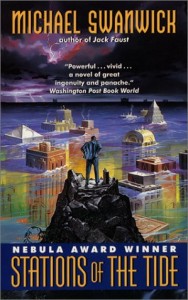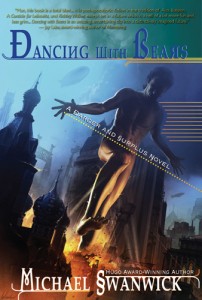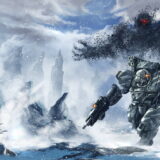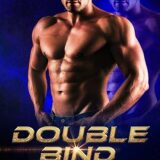
Photo by Shawn McConnell
Note: This interview originally appeared in Amazing Stories Magazine January 29, 2014.
Today we are joined by award-winning author Michael Swanwick. Calling Michael an amazing writer undersells the extreme craftsmanship that he puts into every tale. He paints stories with the same passion and detail as Michelangelo, Raphael, and da Vinci. Michael does not lock himself inside the box of genre expectations. Instead, he creates stories that blend familiar elements in unexpected ways, while exposing the reader to new vistas of imagination and insight.
Michael published his first two stories in 1980, and they were both nominated for Nebula Awards. Since then, his writing has been nominated for countless awards and has won five Hugos, a Nebula, the World Fantasy Award, and the Theodore Sturgeon Memorial Award. Michael has found opportunities to branch beyond fiction. He has written essays and books about the science fiction industry as well as about some of his peers, including the legendary author/editor Gardner Dozois. When not rappelling down the mountain of notebooks collected in his home, Michael spends his time weaving the threads of existence into a new reality.
R. K. TROUGHTON FOR AMAZING STORIES: Welcome to Amazing Stories, Michael. Much has been said about the changing face of science fiction. The amazing Gardner Dozois calls you one of the seven or eight writers of your generation that is shaping the evolution of science fiction. How do you view this evolution, and how do you see your role in it?
MICHAEL SWANWICK: Conventional wisdom is that science fiction and fantasy and horror are all melting together into a single form which might be called fantastika. I don’t believe that. I’m old enough to have seen fantasy separate itself from science fiction, much as steampunk is doing now. The evolution is outward, into a greater variety of forms. Simultaneously, there is no common center to the field anymore. When I started writing, science fiction was small enough that everybody had read a good selection of the same books, had opinions about the latest novels by the major writers, and subscribed to at least one of the magazines. That’s been lost, and it’s a pity.
What’s also a pity, though a less obvious one, is that there’s a lot more emphasis on good writing and a lot less on good ideas. Something you don’t hear much anymore but which was a commonplace when I started writing, is the statement that “Science fiction is the literature of ideas.” The improvement in literary standards is to be applauded. But as important as good writing is—and it is almost everything to me—a well-written story built around a strong idea will outlast a better-written story that’s just a retelling of an old classic.
When I was a teenager I dedicated my life to writing and, in my young hubris, decided that I was going to write highbrow literature that could be enjoyed by the most lowbrow reader. That’s what I’m still trying to do. I don’t see why I can’t have it all. I don’t see why everybody can’t have it all.
ASM: As a writer, you spent years trying to find your voice, even struggling to actually finish a story. Yet, the first two stories you published were both nominated for Nebula Awards. Looking back at the genesis of your career, what was the turning point for you? Was there a eureka moment?
MS: Yes, literally so. One evening in the late 1970s, Jack Dann came to Philadelphia to visit Gardner Dozois, get literary advice from him, plot out collaborations, plan anthologies, and the like. I’d made an attempt at a story which Jack and Gardner read through, sitting aound the kitchen table, and then took apart and reassembled so that it worked. They told me how to turn a soggy mass of words and ideas into a working story and I got it, I understood the process. It was as if God had reached down out of the sky and flicked a switch in my skull. I remember staggering home at three a.m. that night, drunk on the very bad cream sherry that Gardner favored then, knowing that I was finally a writer. And I was. Ever since that moment, writing has only been a matter of time and hard work.
 ASM: Your novel Stations of the Tide captured the Nebula Award and was nominated for the Hugo and Arthur C. Clarke Awards. Gardner Dozois calls it one of the two main post-cyberpunk works. For those that have not read your book, please tell us what we can find within its pages.
ASM: Your novel Stations of the Tide captured the Nebula Award and was nominated for the Hugo and Arthur C. Clarke Awards. Gardner Dozois calls it one of the two main post-cyberpunk works. For those that have not read your book, please tell us what we can find within its pages.
MS: Sex, magic, and television as intangible technologies. A planet where everybody and everything is in the process of becoming something else. A hero with no name. Black constellations. Hallucinogenic rain. Tantric techniques. An intelligent briefcase. When I was writing Stations, I put in all the strangest things I believed to be true and I expected that nobody would understand a word of it. Instead, it turned out to be the most intensely understood novel I ever wrote. For which I am grateful.
In every chapter, I was careful to include an act of magic that I was sure Isaac Asimov could be convinced was feasible in the real world, in an escalating series starting from an act of stage magic. I was also careful not to spell out the novel’s themes, what it was actually about, so that what readers get out of it depends on what they’re looking for. Beyond that, I cannot say. It’s been a long time since I last read it.
ASM: Genre fiction often tries to construct neatly organized boxes to contain everything. Where there is a story, there is someone standing over it placing it comfortably in a box. I picture all the box stuffers standing over your work pulling their hair out trying to find a box for your work. You liberally mix science fiction and fantasy with elements from so many other boxes and subgenres. How would you describe this masterful recombination you create in your fiction?
MS: The secret to ignoring boundaries is to have read so much fiction both in and out of genre that you know not only where the boundaries are but why they’re there. It doesn’t do a lot of good to combine fairies and spaceships, because the reader will find the combination jarring. But Ursula K. Le Guin’s “Semley’s Necklace” does a masterful job of retooling the fantasy trope of Elf Hill to a science fiction setting, and the world-building of her Earthsea books employs a lot of tools she learned from writing science fiction.
George Scithers used to say that rules are not made to be broken—rules are made to be understood. The same with boundaries. Once you know that, they have no power over you.
 ASM: Your novel The Iron Dragon’s Daughter blends traditional elements of fantasy into a science fiction setting. For those that have not yet read the book, please tell us about it.
ASM: Your novel The Iron Dragon’s Daughter blends traditional elements of fantasy into a science fiction setting. For those that have not yet read the book, please tell us about it.
MS: Jane Alderberry is a girl who has been stolen by the elves and put to work in a factory, building dragons—which are sentient, inherently evil, metal machines of war. She manages to steal one and escape into the larger world, a modern industiralized Faerie, only to find that her troubles have just begun: She has to face high school, adolescence, college, and ultimately find a place for herself. But since she’s in a world where she literally doesn’t belong, every attempt to fit in is doomed to failure.
Before this novel, I wrote almost no fantasy, which seemed to me a genre where the British held all the advantages of history, education, and locale. Once I made the conceptual breakthrough of bringing Faerie into modern times, though, I could employ not only automobile junkyards, strip malls, industrial brownfields and the like, but also a very American culture, one in which disparate fantasy races had been dumped into the melting pot and left to simmer in uneasy proximity to each other.
One thing I learned from writing The Iron Dragon’s Daughter is that fantasy is about the unknowable. Throughout Jane’s adventures, the question is repeatedly raised, “What does the Goddess want?” There are many answers, and they all contradict each other, much in the way that a similar question posed in our own world will elicit conflicting responses.
ASM: You have been described as a chameleon in your ability to adapt your writing style to fit the situation and, in some instances, to even mimic an author with whom you may be collaborating. To me, this reveals the keen eye you have for writing. What is your process for analyzing a piece of writing?
MS: I analyze by writing. When a story resists being put into words, I’ll cast about in my memory to find how other writers tackled the same chore. I had trouble starting “Slow Life,” a hard SF story set on Titan, so I went through Larry Niven’s early collections of short fiction, because they had a feel I thought would work well there, and I found that he often started a story with a short science lecture. So I began my story with an analysis of the chemistry of a raindrop falling through the atmosphere. That worked, and I thank Mr. Niven for it.
The hardest challenge I ever faced was expanding “Vergil Magus, King Without Country,” an unpublished story by Avram Davidson, to make it accessible to the average genre reader. Avram’s prose was brilliant but, taken cumulatively, rather daunting, and the plot only became apparent at the story’s end. So I broke his work into sections and alternated them with an action-filled sequence of events, to keep the reader involved enough to read through and discover what a cunning plot he’d actually come up with. I found that the only way to counterfeit Avram’s prose was to steal snippets of it from other works of his, primarily the Adventures in Unhistory essays, to lend a sense of richness to what I’d written.
There’s really no system for any of this. The English language is too rich and literature too diverse to be reduced to one. Whatever works, works. Which is what makes finding out what works so much fun.
 ASM: What was your first exposure to science fiction, and what got you hooked on the genre?
ASM: What was your first exposure to science fiction, and what got you hooked on the genre?
MS: As a child, I read science fiction along with everything else—The Space Ship Under the Apple Tree, The Wonderful Flight to the Mushroom Planet, all the Tom Swift Jr. books, and so on—but indiscriminately, along with everything else. Then, at age sixteen, I discovered J. R. R. Tolkien’s Lord of the Rings trilogy and my fate was sealed. I wanted to be a writer and specifically a fantasy writer. By the time I got to college, I’d read pretty much every work of fantasy ever written, and started reading science fiction because it gave me a fantasy-like “kick.” (There were a lot of fantasy writers who were essentially hiding out in science fiction at the time, writing what would have been fantasy if the hero hadn’t arrived in the land of marvels via a spaceport, which was referred to at the beginning of the novel, never shown, and quickly forgotten.) By degrees, my primary loyalty shifted away from fantasy because science fiction required all the skills needed to write fantasy but also a knowledge of science and the ability to make it integral to the story. Young writers are ambitious and science fiction seemed more difficult to write, and so I was naturally drawn to it.
Nowadays I find myself more and more drawn to fantasy, because it has so much untapped potential. Science fiction is a mature genre, but fantasy seems to be just hitting its stride. So I may be coming full circle with my younger self. Then again, it all depends on what ideas come to me. I could as happily spend the rest of my life writing science fiction.
ASM: What was the very first thing you wrote, and how old were you when you wrote it?
MS: My mother was careful to teach her children how to read before we went to grammar school, as a way of innoculating us from bad teachers. So I was writing from an early age, the same as I was drawing or making up songs. My first complete and coherent (if not very good) story was “The Theoretical Man,” written at age 17 in order to get into a writing class that was normally not available to college freshmen. It was about a man who comes to suspect he’s a computer program, was published in my college literary magazine, and will never be reprinted. I then spent the next eleven years writing furiously and never finishing anything, which was good because when my first stories came out, I had a very polished prose line, and so I got noticed.
One amusing bit of trivia about that first story is that it contained the line, “The sky was a cathode-tube grey.” As a result, though I greatly admire everything else William Gibson has ever published, I was never very impressed by the famous first line of Neuromancer, “The sky above the port was the color of television, tuned to a dead channel.” It sounded too much like something I’d written.
ASM: Some authors go through extreme effort to outline and detail every element of their stories before they begin writing. Others dive head first with no plan or direction. What does your writing process look like?
MS: It’s kind of a hot mess. Usually, I come up with an idea and play around with it until I come up with the first line. Then I jot that down. I start creating characters, situations, details, individual lines of dialogue, and finally—sometimes this takes years – I find the ending and the last line. Then I go to the first line and start writing, aiming the story or novel at its conclusion, while not knowing how it’s going to get there. I rewrite constantly as I go, so that every page has been thoroughly reworked ten or twenty times; as a result, when I finally do reach that last line, I only have the last several pages to rewrite. In the middle stages, I’ll draw lots of plot diagrams in order to figure out how each section should go.
This is not a method I would recommend to anyone. But, with rare exceptions, it’s what works for me.
 ASM: Looking back at your career, what authors and editors have influenced you the most?
ASM: Looking back at your career, what authors and editors have influenced you the most?
MS: Gardner Dozois taught me a tremendous amount over the years, both as an author and an editor, for which I am forever grateful. From their work, I’ve learned most from Gene Wolfe, Ursula K. Le Guin, Joanna Russ, and Samuel R. Delany. Among mainstream writers, it’s Vladimir Nabokov and Thomas Pynchon, and a great many others whose works border upon the fantastic. These are all hero-writers, giants, and their work is always crammed with ideas.
A fifth science fiction writer I should give credit to is Everybody Else. As a gonnabe writer, I read voraciously as if all of science fiction had been created by a single multifaceted genius writer. That was the writer I aspired to become.
From editors, not so much. Mostly, they’ve left my work alone.
ASM: Now into your fourth decade of publishing, how has science fiction and the publishing industry changed since you first started?
MS: When I started out, everybody knew what you should do to make a career. If you worked hard and took the advice of your elders, you could rise to your natural level. It might be as a popular writer of entertaining fiction or as a respected writer of difficult work with a much smaller audience, but you wound up with a kind of rough justice. Nowadays, nobody knows what the rules are.
I worry that there are worthy writers self-publishing themselves into oblivion. The best advice I can give them is to boot up the last twenty self-published novels they’ve bought and ask themselves how they heard of those writers. Then do likewise. But if they don’t have a good plan, they’re best off going old-school and sending their stories to magazines and their novels to publishing houses.
Where art and business collide, the consolidation of publishing houses by multinational conglomerates has been very hard on the art. I recall one acquisition when my editor was told that she was going to fire her editorial assistants. When she pointed out that she could only do half as much editing without them, she was given two choices: Publish her books with less editing or publish half as many books, edited as thoroughly as before. She valued the books over her input and God bless her for that. But no editor should ever be put in such a position—and our culture is poorer for it, because she was a very good editor.
ASM: Fans have a unique relationship with authors; they seem to feed off of each other. Authors share their intricate imagination and skill, while fans often provide inspiration and motivation. How do you view the importance of fandom to the continued evolution of science fiction?
MS: This will sound dismissive, but it’s not. The chief service that fans provide writers is in putting on science fiction conventions where writers can interact with each other. Writing is a solitary profession, and you can end up feeling extremely isolated. But when you can go to a con and chat with Robert Silverberg or Nancy Kress and they tacitly acknowledge your existence, there’s no need for you to buttonhole strangers at parties and explain that you really are a writer, honest!
It’s also useful to spend time talking with fans, because it impresses upon you the fact that most of them—and by extension, most readers—are perfectly intelligent people who don’t necessarily defer to your every opinion. On the whole, the mainstream writers I have met have been delightful people, but once in a blue moon I’ll run across one who is so pompous and pretentious that he’s (it’s almost always a male) reduced himself to a comic stereotype. That wouldn’t happen if he’d had the opportunity to meet more of his readers.
 ASM: Your novel Dancing with Bears follows the adventures of a pair of rogues, Darger and Surplus. Please tell us how the pair came into existence and what we might hope to see from them in the future.
ASM: Your novel Dancing with Bears follows the adventures of a pair of rogues, Darger and Surplus. Please tell us how the pair came into existence and what we might hope to see from them in the future.
MS: I was reading Thomas Pynchon’s Mason & Dixon, which contains a wonderfully engaging talking dog. Instantly, I conceived the desire to create my own talking dog. To ensure that mine was an independent creation, I set him up on two legs and dressed him up in a manner such as one might encounter in an illustrated collection of Mother Goose rhymes. I put him onto the docks of London in a post-Utopian future I’d been playing with in my imagination. Then, because I needed someone for him to talk to, I had him approached by a nondescript con man named Aubrey Darger. At which point, the two rascals seized control of the plot and ran off with it, leaving me scurrying after them, scribbling madly, and crying, “Wait up! Wait for me!”
After setting fire to London in their first adventure, Darger and Surplus set off for various parts of Europe and then Moscow, always heading for a new destination at the end of each adventure and—because they’re infinitely distractable – popping up somewhere else at the beginning of the next one. They’re always looking for a new score, and ever moving eastward. They don’t realize it but they’re on an accidental trip around the world. Ultimately, Surplus must return to the Demesne of Western Vermont to confront certain secrets from his past, and Darger must revisit the slums of Mayfair to learn what has become of his childhood.
I’ve just finished their second novel, Chasing the Phoenix, in which they (again, unintentionally) conquer China. Literally, I mean, with armies and such. They also realize—nor did I, at first—that they are putting an end to their age. By the time their journey is done, the world will be a very different place as a result of their actions.
ASM: Over the years, you have worked with and/or studied many greats within the science fiction industry. Please provide a brief character sketch of the following people:
ASM: Gardner Dozois
MS: There are two sides to Gardner. One is the jolly Rabelaisian scoffer he likes to present himself as being. But he’s also a pessimist and a stoic as well as being one of the smartest men I’ve ever met. He has a blue collar background and as a result went into the army rather than college, which shaped much of his self-image. If it had been the other way around, I’m sure he’d still be in science fiction as a writer and editor. But he’d also be respected as an intellectual.
I can hear him jeering at my saying that, but it’s true.
ASM: William Gibson
MS: I was hanging out with Jack Womack one winter day when he mentioned that his jacket was from Buzz Rickson’s William Gibson Collection. A second before it had seemed perfectly ordinary, but now it looked unspeakably cool. That’s kind of what Gibson himself is like: the real thing. If you could somehow surgically remove from Bill everything that makes him cool, he couldn’t be bothered to walk across the street to retrieve it. That’s the essence of cool, not caring about nonessentials.
As a writer, he deserves all the praise he’s received. I collaborated on “Dogfight” with him back when we were both unknowns largely because I wanted to see what kind of chops he had. Early on, when I wasn’t certain yet whether the story could be done, he wrote a paragraph-long description of a pool hall that not only nailed the scene but held implicit within it everything that I wanted to do with the story. “We can write this puppy!” I said aloud, and I’m still pleased with how it came out.
ASM: Gene Wolfe
MS: When I first met him, Gene had a day job and looked like the most ordinary person in the world. In fact, I modeled the protagonist of Stations of the Tide after him—a man who on the outside looked like nobody special but on the inside was Gene Wolfe. After he left Plant Engineering, he cultivated that extraordinary mustache and acquired a wary, almost lupine expression.
I find him very pleasant company on those rare occasions when we meet, but I’m always aware of his formidable intellect, the way that wolfpack members are always aware that their leader could rip them apart if he wanted. There are not many people so smart as to be literally scary. Gene’s one of them.
ASM: Michael Swanwick
MS: The artist Hokusai signed his prints and paintings “Old Man Mad About Drawing.” In a few years, I’ll be able to call myself Old Man Mad About Writing. Writing isn’t just how I earn a living. My hobby is writing criticism and non-fiction. In spare moments, I’ve crafted hundreds of short-shorts, some of which are written on lamps, a carafe, a mask, and other odd objects scattered about my house. Sometimes I write in my sleep. Occasionally I interview other writers. I’m always coming up with new ideas for things to do with words.
Other than that, I think I’m a pretty ordinary guy. But that’s not necessarily how others see me. My friend Stanley was driving through my neighborhood once with his daughter Nell and young granddaughter Cassandra. He was telling Nell something about me when he saw me walking down the sidewalk, lost in thought, as usual. “Speak of the devil,” Stanley said, “there he is!”
They drove on and when I was out of sight Cassandra said, in a very small voice, “Pop-pop, was that really the Devil?”
ASM: Your novella House of Dreams just arrived on the Kindle. It is the fourth in your Mongolian Wizard series. What are you working on now, and what can we look forward to seeing from you in the near future?
MS: I’ve got three more Mongolian Wizard stories in various stages of completion and anticipate telling the entire story of the war over the course of perhaps a dozen more; just enough, coincidentally enough, to fill a collection. I’ve already mentioned Chasing the Phoenix, and I’m currently doing the research for a third and final iron dragon novel, one that answers all the questions raised by The Iron Dragon’s Daughter and The Dragons of Babel. There’s a new Darger & Surplus story coming out soon in Rogues, edited by Gardner Dozois and George R. R. Martin, and another one half written, about the time Darger was swallowed by a dragon. Plus a dozen or so standalone stories that are at least half written. I’m pondering a novel-length fantasy about Philadelphia. My wife, Marianne Porter, is after me to write a YA novel with Lizzie O’Brien, the protagonist of “Slow Life,” but I’m not sure I have the time. We’ll see.
 ASM: For someone new to your fiction, where should they start first?
ASM: For someone new to your fiction, where should they start first?
MS: If they like fantasy, The Iron Dragon’s Daughter. If they prefer science fiction, Stations of the Tide. If it’s hard SF they like best, then Bones of the Earth, which at time of publication was as scientifically accurate as a dinosaur novel could be made. (Paleontology is changing fast!) Those who prefer short fiction – and these are my brothers and sisters—can start anywhere.
ASM: Thank you for joining us today. We always trust that when we read one of your tales we will experience something new and exciting that will shape our imaginations. You are truly an architect of possibilities. Before you go, is there anything else you would like to share with the readers of Amazing Stories?
MS: I’m not commonly thought of as a hard science fiction writer, but the science geek in me goes deep, and so does the space advocate. In the United States, most people think that the Age of Space is over. But not only are there American astronauts in space at this very moment, but there are active space programs in China, India, Japan, Europe, Russia, Ukraine, Iran, South Korea, the U. K. . . and the list goes on. There are many good reasons for this, but the chief one is that the emergence of life from the planet is the single greatest enterprise of our age, and the one for which we’ll be remembered when all our wars and atrocities are mercifully forgotten. Who wouldn’t want to be a part of that? Who wouldn’t want a piece of the credit? Everyone should grab a tub of popcorn and pay as much attention to all these programs as humanly possible. The move into space isn’t happening on the schedule or in the manner we thought it would back in the 1950s. But it’s happening.
New writers should pay particular attention. There are major reputations to be made for those who can show us how it’s really going to happen.
End of sermon. Everybody can go back to their reading now.











